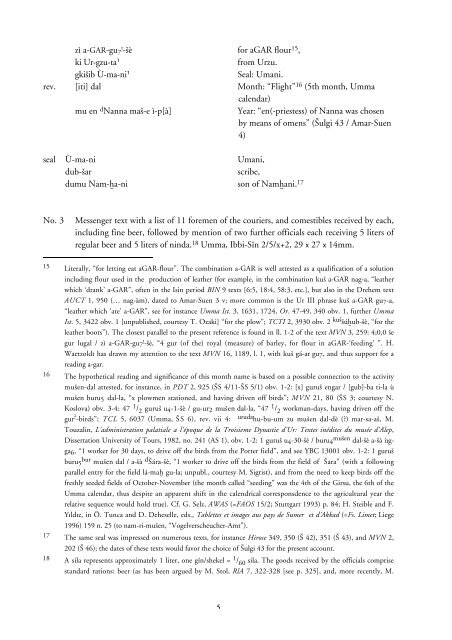PDF copy - Cuneiform Digital Library Initiative - UCLA
PDF copy - Cuneiform Digital Library Initiative - UCLA
PDF copy - Cuneiform Digital Library Initiative - UCLA
Create successful ePaper yourself
Turn your PDF publications into a flip-book with our unique Google optimized e-Paper software.
zì a-GAR-gu7 !-Òè for aGAR flour 15 ,<br />
ki Ur-gzu-ta» from Urzu.<br />
gkiÒib Ù-ma-ni» Seal: Umani.<br />
rev. [iti] dal Month: “Flight” 16 (5th month, Umma<br />
calendar)<br />
mu en d Nanna maÒ-e ì-p[à] Year: “en(-priestess) of Nanna was chosen<br />
by means of omens” (∑ulgi 43 / Amar-Suen<br />
4)<br />
seal Ù-ma-ni Umani,<br />
dub-Òar scribe,<br />
dumu Nam-Ìa-ni son of NamÌani. 17<br />
No. 3 Messenger text with a list of 11 foremen of the couriers, and comestibles received by each,<br />
including fine beer, followed by mention of two further officials each receiving 5 liters of<br />
regular beer and 5 liters of ninda. 18 Umma, Ibbi-Sîn 2/5/x+2, 29 x 27 x 14mm.<br />
15 Literally, “for letting eat aGAR-flour”. The combination a-GAR is well attested as a qualification of a solution<br />
including flour used in the production of leather (for example, in the combination kuÒ a-GAR nag-a, “leather<br />
which ‘drank’ a-GAR”, often in the Isin period BIN 9 texts [6:5, 18:4, 58:3, etc.], but also in the Drehem text<br />
AUCT 1, 950 (… nag-àm), dated to Amar-Suen 3 v; more common is the Ur III phrase kuÒ a-GAR gu7-a,<br />
“leather which ‘ate’ a-GAR”, see for instance Umma Ist. 3, 1631, 1724, Or. 47-49, 340 obv. 1, further Umma<br />
Ist. 5, 3422 obv. 1 [unpublished, courtesy T. Ozaki] “for the plow”; TCTI 2, 3930 obv. 2 kuÒÒúÌub-Òè, “for the<br />
leather boots”). The closest parallel to the present reference is found in ll. 1-2 of the text MVN 3, 259: 4;0,0 Òe<br />
gur lugal / zì a-GAR-gu7 !-Òè, “4 gur (of the) royal (measure) of barley, for flour in aGAR-‘feeding’ ”. H.<br />
Waetzoldt has drawn my attention to the text MVN 16, 1189, l. 1, with kuÒ gá-ar gu7, and thus support for a<br />
reading a-gar.<br />
16 The hypothetical reading and significance of this month name is based on a possible connection to the activity<br />
muÒen-dal attested, for instance, in PDT 2, 925 (∑S 4/11-∑S 5/1) obv. 1-2: [x] guruÒ engar / [gub]-ba ti-la ù<br />
muÒen buru5 dal-la, “x plowmen stationed, and having driven off birds”; MVN 21, 80 (∑S 3; courtesy N.<br />
Koslova) obv. 3-4: 47 1 / 2 guruÒ u4-1-Òè / gu-ur2 muÒen dal-la, “47 1 / 2 workman-days, having driven off the<br />
gur ? -birds”; TCL 5, 6037 (Umma, ∑S 6), rev. vii 4: urudahu-bu-um zu muÒen dal-dè (?) mar-sa-aÒ, M.<br />
Touzalin, L'administration palatiale a l'époque de la Troisieme Dynastie d'Ur: Textes inédites du musée d'Alep,<br />
Dissertation University of Tours, 1982, no. 241 (AS 1), obv. 1-2: 1 guruÒ u4-30-Òè / buru4 muÒen dal-Òè a-Òà ùgga6,<br />
“1 worker for 30 days, to drive off the birds from the Porter field”, and see YBC 13001 obv. 1-2: 1 guruÒ<br />
buru5 bur muÒen dal / a-Òà d∑ára-Òè, “1 worker to drive off the birds from the field of ∑ara” (with a following<br />
parallel entry for the field lá-maÌ gu-la; unpubl., courtesy M. Sigrist), and from the need to keep birds off the<br />
freshly seeded fields of October-November (the month called “seeding” was the 4th of the Girsu, the 6th of the<br />
Umma calendar, thus despite an apparent shift in the calendrical corresponsdence to the agricultural year the<br />
relative sequence would hold true). Cf. G. Selz, AWAS (=FAOS 15/2; Stuttgart 1993) p. 84; H. Steible and F.<br />
Yıldız, in Ö. Tunca and D. Deheselle, eds., Tablettes et images aus pays de Sumer et d’Akkad (=Fs. Limet; Liege<br />
1996) 159 n. 25 (to nam-ri-muÒen, “Vogelverscheucher-Amt”).<br />
17 The same seal was impressed on numerous texts, for instance Hirose 349, 350 (∑ 42), 351 (∑ 43), and MVN 2,<br />
202 (∑ 46); the dates of these texts would favor the choice of ∑ulgi 43 for the present account.<br />
18 A sila represents approximately 1 liter, one gín/shekel = 1 / 60 sila. The goods received by the officials comprise<br />
standard rations: beer (as has been argued by M. Stol, RlA 7, 322-328 [see p. 325], and, more recently, M.<br />
5
















